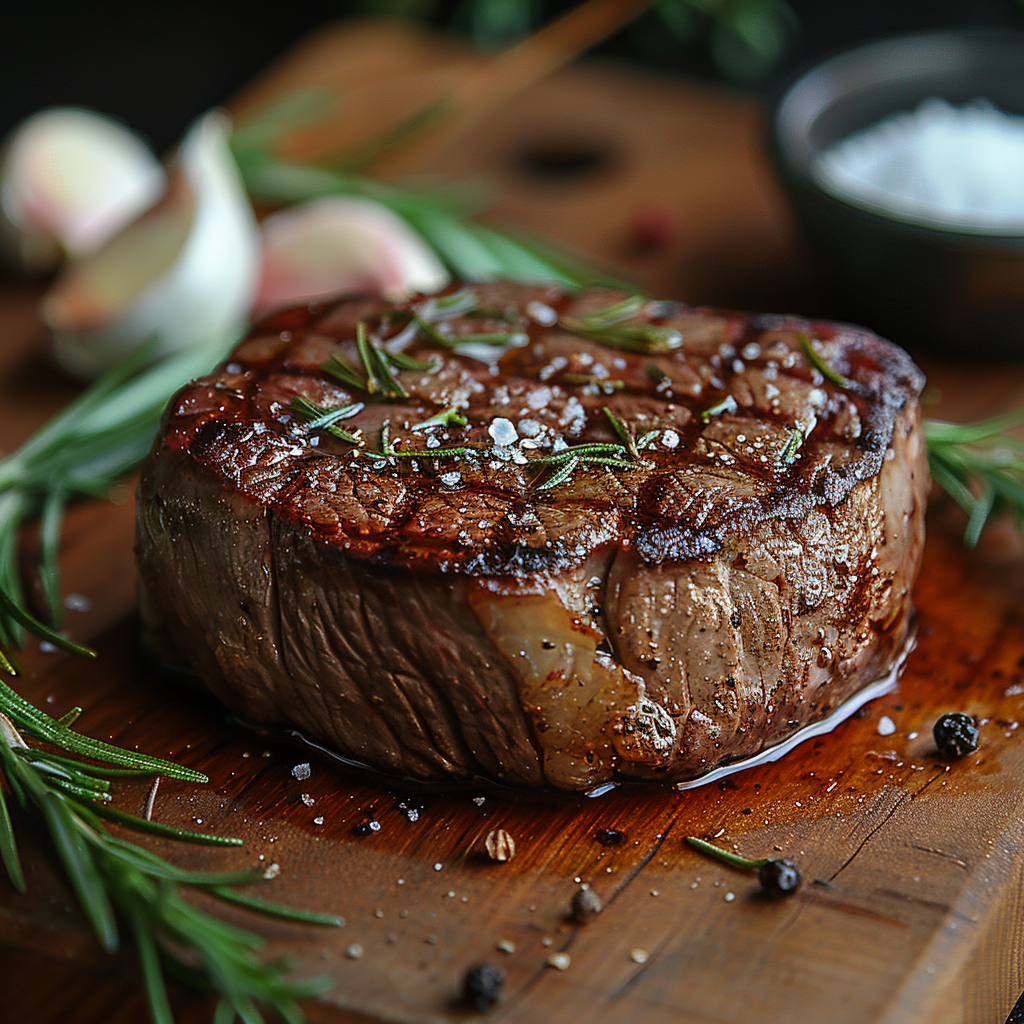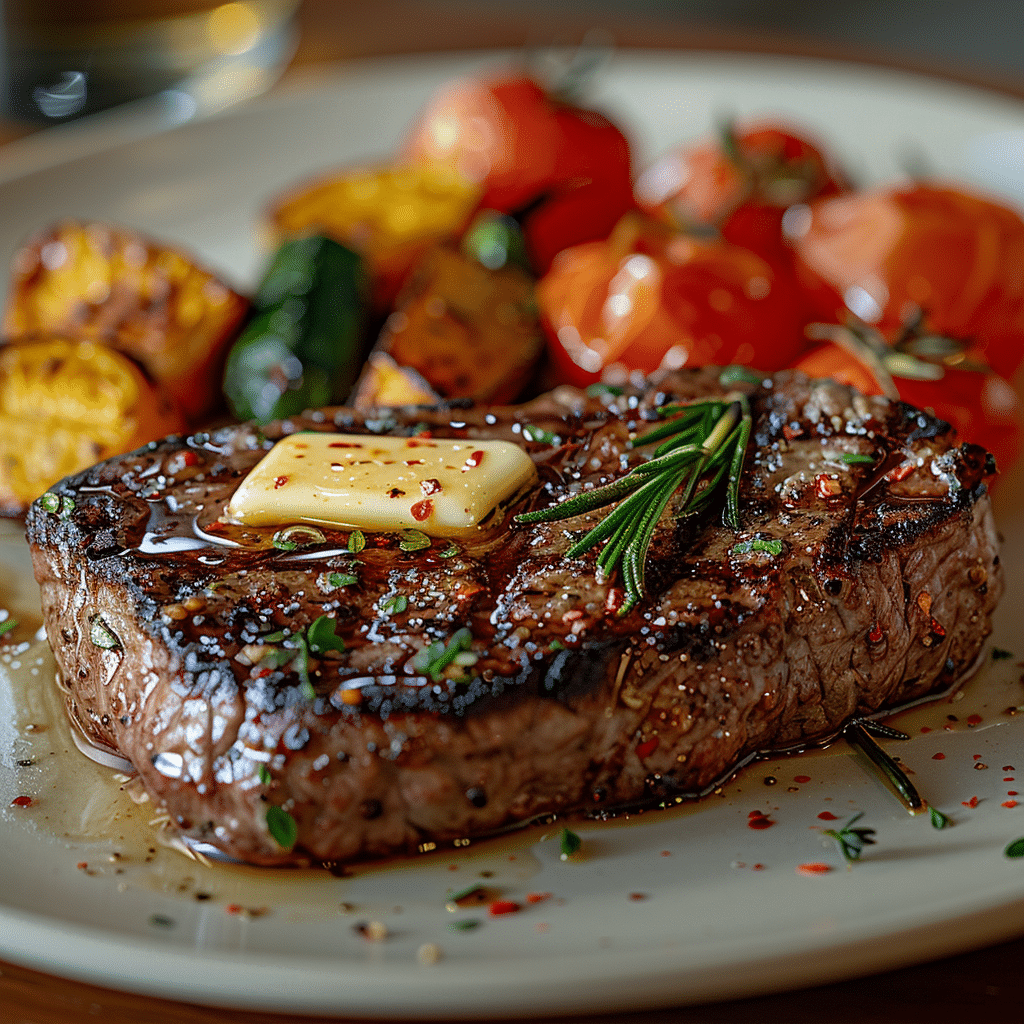Perfectly Cooked Steak in a Vacuum Sealed Bag
Jump to Recipe
Have you ever wondered how you can achieve a restaurant-quality steak at home without any guesswork?
If you cook steak in a vacuum-sealed bag using the sous vide method, you will always get the same exact results. Envision a perfectly cooked steak that evenly distributes heat throughout the meat. You will no longer need to slice your meat to check its doneness or tolerate uneven cooking.
I’ll walk you through this game-changing recipe and show you how simple and foolproof it can be to make gourmet food at home. Get ready to change the way you cook steak with precision cooking, and enjoy the flavor and texture that only sous vide steak can give you.
The basics of vacuum sealing
Vaccum sealing takes the air out of a plastic bag to make a seal that keeps air out. It’s a big deal for keeping food fresh because it slows down spoilage and stops freezer burn. Because of this process, a vacuum sealer is also an important piece of kitchen equipment for getting ingredients ready, especially for sous vide cooking.
You can choose from the following types of vacuum sealers:
- Handheld vacuum sealers are easy to carry and work well for small jobs.
- External vacuum sealers are great for large sealing jobs at home.
- Chamber vacuum sealers are professional-grade and excellent for sealing a lot of items at once.
There are pros and cons to each type of vacuum sealer, so pick the one that works best for you. If you have the right vacuum sealer, your steak will be ready for low-temperature cooking, which will make it taste great and be tender.
Why choose low-temperature cooking?
Low-temperature cooking, especially sous vide, has amazing benefits that make my cooking better. It changes everything about kitchen science.

Results You Can Trust
One great thing about sous vide is that the results are always the same. With precise cooking, the steak cooks the same way all the way around. It eliminates the need for constant guesswork and constant monitoring, ensuring consistently perfect cooking.
Better taste and texture
The improved taste and texture are another strong benefit. Sous vide cooking keeps the meat’s moisture and flavor in, so there’s less chance of getting a dry or overcooked steak. While cooking, this method keeps the meat juicy and tender, making for a delicious meal.
Stayed Nutrients
Lastly, sous vide cooking helps keep more of the food’s nutrients than cooking it at high temperatures. Carefully cooking the steak at lower temperatures protects its important vitamins and minerals. This makes the food taste better and better for you.
How to Get Your Steak Ready to Vacuum Seal
It’s essential to get your steak ready to vacuum seal. It makes sure that every bite is full of flavor. Start by cooking the meat the right way. Pick a tasty cut, like a ribeye or filet mignon, because they have a lot of marbling. Cut off any extra fat so that there isn’t too much grease in the bag.
Next, work on seasoning the steak. Add a lot of salt and pepper. I often add garlic powder or rosemary to make the taste stronger. A lot of people also like to put butter, herbs, and spices right into the vacuum bag.
Here are some tips for getting ready to cook. Use a paper towel to dry off your steak. This step keeps any moisture that is still there from messing up the vacuum seal. The flavors will concentrate better.
Lastly, it’s important to lay the steak flat in the bag. Don’t let them overlap. This ensures uniform cooking throughout. The steak will have the flavor of a restaurant if you follow these steps.
Here’s how to cook steak in a vacuum-sealed bag.
When you cook steak sous vide, it always comes out perfectly done. Let’s go through this exact way of cooking one step at a time.
Setting up the sous vide
Setting up the sous vide is the first and most important step. Put water in a large pot or container, and connect your precision cooker to it. Set the steak to the temperature you want. Most of the time, 130°F is perfect for medium-rare.
Stick the vacuum-sealed bag to the side of the pot with clips, and make sure the sous vide setup is stable. This keeps it from sinking and makes sure it cooks evenly.
Vacuum Sealing the Steak
For this cooking method to work, you must properly seal the vacuum. Make sure the steak is flat and free of air pockets before putting it in the vacuum bag. Use a reputable vacuum sealer to close the bag. This stops bacteria from growing and makes sure the food cooks evenly all the way through.
How Long to Cook
Different cuts and thicknesses of steak need different amounts of time to cook. After heating the water bath, place the vacuum-sealed steak in it. To get a one-inch-thick steak just right, cook it for about an hour to two hours.
Change the cooking time depending on how you like your food. This specific way of cooking helps keep the steak’s juicy, succulent texture.
Searing the Steak: Finishing Touches
Your steak is almost cooked through the sous vide process, but it still needs one more important step: the sear. This last touch can really make the dish stand out.
Why do you need Sear?
The Maillard reaction gives the steak a tasty crust when you sear it. This changes the steak into restaurant-quality steak by giving it more complex flavors and a great texture.
How to Sear
Select the searing method that is most effective for your kitchen to achieve the perfect crust.
- For the cast iron skillet, heat it up until it’s very hot. Add a small amount of oil with a high smoke point. Grill one side at a time for one to two minutes.
- Use a blowtorch if you’d rather have more control. Place the flame just above the surface, and move it around until you see the crust form.
No matter which way you choose, make sure the steak doesn’t get too done during the sear, so the inside stays juicy.
Serving ideas and food pairings
Once you have mastered the art of cooking, it’s time for the big finale: serving a delicious meal that will make everyone happy. Plating methods are very important in this case. Putting the steak in the middle of the plate is how I like to start. You can add color and style with garnishes like fresh herbs or a drizzle of balsamic reduction.
A lot of different side dishes go well with your vacuum-sealed steak. Vegetables roasted in the oven or mashed potatoes can bring out the rich flavors of the meat. If you’d rather have something lighter, a fresh garden salad is a refreshing change.
A steak dinner isn’t complete without the right wine to go with it. To bring out the flavor of the steak, choose a strong red wine like Cabernet Sauvignon or Merlot. If wine isn’t your thing, a well-made beer can also be a wonderful choice. If you follow these tips, you’ll always have a memorable dining experience.

Perfect Sous Vide Steak
Ingredients
Method
- Select the Steak: Choose high-quality cuts like ribeye or filet mignon.
- Season: Generously season steaks with salt, pepper, and minced garlic. Add rosemary or thyme.
- Add Butter: Place a pat of butter on each steak.
- Pat Dry: Use a paper towel to dry the steaks.
- Bagging: Place each steak in a vacuum-seal bag, ensuring they lie flat and do not overlap.
- Seal: Use a vacuum sealer to remove the air and seal the bags.
- Setup: Fill a large pot or container with water and attach your sous vide precision cooker.
- Temperature: Set the cooker to 130°F (54°C) for medium-rare.
- Cook: Attach the vacuum-sealed bags to the side of the pot using clips to keep them submerged. Cook for 1-2 hours.
- Preheat Skillet: Heat a cast iron skillet over high heat until very hot.
- Sear: Add a small amount of oil. Sear each side of the steak for 1-2 minutes until a crust forms.
- Rest: Let the steak rest for a few minutes before serving.
Notes
- Cooking Times: Adjust the sous vide cooking time based on steak thickness: 1-2 hours for 1-inch thick, 2-4 hours for thicker cuts.
- Temperature: For different doneness levels, adjust the temperature (e.g., 135°F for medium, 140°F for medium-well).
- Resting: Allowing the steak to rest after searing helps retain its juices.
FAQ
What is sous vide cooking?
The French phrase “sous vide” means “under vacuum.” This method involves sealing food in a vacuum-sealed bag and cooking it in a water bath at a precisely controlled temperature. This way of cooking makes sure that the food cooks evenly and keeps its natural flavors and nutrients.
How does vacuum sealing benefit food preservation?
By vacuum sealing, you eliminate the air from a plastic bag, creating an airtight seal. This keeps food from going stale and stops freezer burn. With this method, food stays fresher for longer and has a longer shelf life.
Why should I consider low-temperature cooking?
Low-temperature cooking, particularly sous vide, consistently produces uniform results. When compared to traditional cooking methods, it keeps more nutrients, improves flavor and texture, and locks in moisture.
How should I prepare my steak for vacuum sealing?
To cook steak the right way, you need to choose a suitable cut, season it well, and sometimes add herbs or butter to the bag. To get a perfect vacuum seal and concentrated flavors, you need to cut off any extra fat and pat the steak dry.
What is the process of cooking steak in a vacuum-sealed bag?
Set up your sous vide tools, such as a water bath and a precision cooker, first. Attach the vacuum-sealed bag with the steak to the side of the pot so it doesn’t sink. To ensure even cooking, ensure the vacuum seal is intact and adjust the cooking time according to the desired level of doneness.
Why is searing the steak important after sous vide?
Through the Maillard reaction, searing makes a caramelized crust that takes the steak to a restaurant-quality level by adding complex flavors and a contrast in textures. It’s an important last step after sous vide cooking.
What are some serving suggestions and pairings for a sous vide steak?
Making your steak look appealing on the plate is important if you want to impress your guests. A good wine goes well with a meal, and I suggest choosing an old vintage that goes well with the rich flavors of the steak. Along with the main dish, side dishes and seasonings are crucial for making a meal complete and memorable.